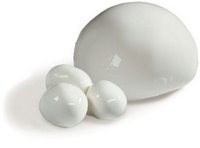
I'm not really complaining about more cheese, because we actually made cheese in class today. (Yep, another skill set I can add to my resume: "cheesemaker.") (Stop laughing.) (Skillz are good.)
We made several different kinds of fresh cheeses. Everyone had to make fresh mozzarella, which is great fun, and then we did some cheeses by teams--ricotta, queso blanco, mascarpone, and lemon cheese. We also took some of the fresh mozzarella and rolled it up with a walnut-basil pesto as sort of a rouladen or pinwheel.
Cheese making in your home (or classroom) kitchen is actually pretty easy to do. You don't need a cow or a goat, but you may need some specialty products for some of the cheeses.
Essentially you need whole milk, heavy cream, or half-and-half; and some sort of acid, like lemon juice, cider vinegar, tartaric acid, or citric acid. If you're making mozzarella, you'll need to purchase some mozzarella curd, because not a lot of people have rennet lying around.
Lemon cheese is a lot like Boursin in texture with a lemony flavor, according to Chef Pantry. (We don't know this yet, because we have to let the cheeses hang and drain/dry until Wednesday's class, when we'll get to actually taste them. I'll report back on how they turned out later this week.) Basically, you heat milk and heavy cream and add lemon juice and stir until it thickens. Rest at room temp for 3-4 hours, then bundle it up in cheesecloth and let it drain over a bowl in the fridge for 8-12 more hours. Then, you can add some lemon zest and pepper and press it into a mold. See, easy.
Mascarpone is that expensive little tub of Italian cheese that is one of the main ingredients of tiramisu...that, and those damn ladyfingers that you can never find when you need them. Chef gave us a recipe for mascarpone that will probably save tons of money. Sure, it has heavy cream, which is expensive, but when compared to that little tub o' cheese goo, it's a real cost saver.

Mascarpone (makes 32 fl oz; adjust as necessary)
64 fluid ounces heavy cream
1/2 tsp tartaric acid (found it online for 7.50 for 4 ounces, which will make a lot of mascarpone)
Heat cream to 180°F, stirring often to prevent scorching. Remove from heat. Add tartaric acid and let cream coagulate into a curd.
Drain curd for at least 24 hours under refrigeration in a strainer lined with a coffee filter. Mascarpone is ready to use, or you can store it in a covered container under refrigeration for up to 7 days.
The coolest thing by far today was making fresh mozzarella. That was neat, and we got to eat some, too.

I really, really love caprese salad with fresh mozzarella slices, some ripe tomatoes, a little basil chiffonade and drizzled with just a little olive oil and maybe a balsamic reduction. That's my idea of summer heaven. And, mid-fall heaven, too. I had some grape tomatoes, little balls of mozzarella (from the expensive trip to the farmer's market), some fresh basil, so I whipped up a little caprese to go with dinner tonight.
If you want to make your own mozz, you need some mozzarella curd, which you'll have to purchase. Todaro Brothers seems to have a fairly reasonable price for the curd, so you might want to give it a whirl. The rest of the ingredients are extremely cheap: water and salt. Whoo hoo!
The key to proper cheese making seems to lie in getting the temperature right. All our recipes were very specific on the temperature that the water or milk needed to be at to have the magic of cheese occur. The mozz was the simplest, because you essentially melt the curd, then work it into the shape you want. Don't overwork it, because it can get tough.
Fresh Mozzarella Cheese (yields 2 lbs.)
3 oz salt
1 gal water
2 lbs cheese curd, cut into 1/2-inch cubes
Procedure
Add salt to the water and bring it to 160°F. Remove pot from heat. Lower cheese curd in a colander into the hot water, completely submerging the curds.
Work the curd with wooden spoons, stretching it until it becomes a smooth but stringy mass. Maintain water temperature at a constant 160°F. (We actually left the pot on the eye with the flame on for this stage.)
Remove cheese from water after all the curds have melted and been incorporated. You want it to look sort of shiny.
Working quickly, shape cheese into balls of various sized as you like. Use a dish of ice water to cool your hands as you shape. Store the cheese balls covered and under refrigeration for up to 5 days.
See, told you it was easy. You too can have skillz, mad skillz, I tell you! (And, 2 recipes today!! Can you believe it?)


No comments:
Post a Comment